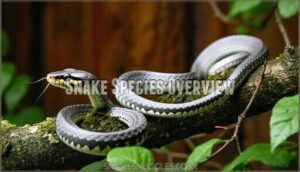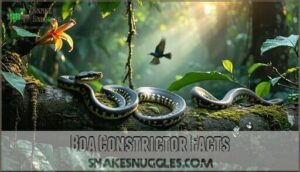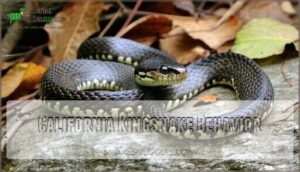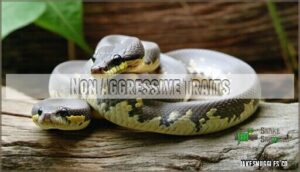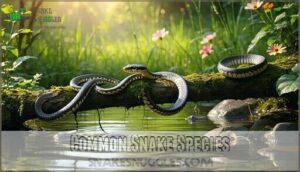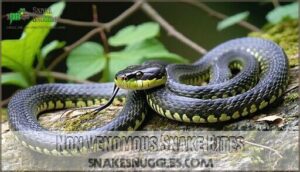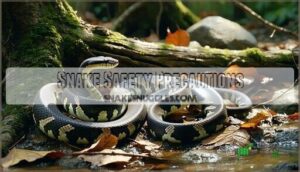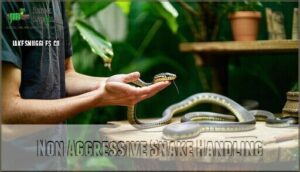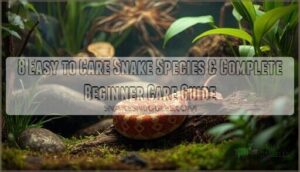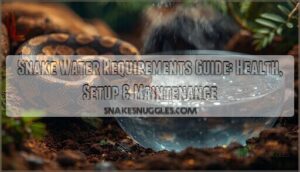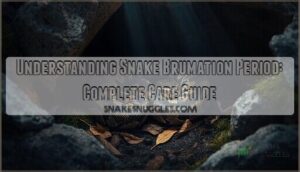This site is supported by our readers. We may earn a commission, at no cost to you, if you purchase through links.
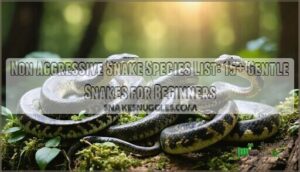 You’ll find plenty of gentle options in any non aggressive snake species list.
You’ll find plenty of gentle options in any non aggressive snake species list.
Corn snakes, ball pythons, and garter snakes top the charts for docile temperaments – they’d rather hide than bite.
Eastern ratsnakes and hognose snakes prefer dramatic displays over actual aggression, while ribbon snakes and green snakes barely register your presence.
Even larger species like boa constrictors maintain surprisingly calm dispositions when properly handled.
These peaceful reptiles rely on camouflage and escape tactics rather than confrontation, making them perfect for beginners who want reptilian companionship without the drama.
Understanding their defensive behaviors reveals fascinating survival strategies that’ll change how you view these misunderstood creatures.
Table Of Contents
- Key Takeaways
- Non Aggressive Snakes
- Snake Species Overview
- Large Non Aggressive
- Non Aggressive Traits
- Common Non Venomous
- Frequently Asked Questions (FAQs)
- What snakes are not aggressive?
- What is the friendliest species of snake?
- Which snake is the calmest?
- What are the six types of snakes?
- What types of snakes are non venomous?
- Are non venomous snakes dangerous?
- Are gopher snakes venomous?
- Are snakes poisonous?
- Can venomous snakes breed?
- Are smooth snakes venomous?
- Conclusion
Key Takeaways
- You’ll find docile temperaments in corn snakes, ball pythons, and garter snakes – they’d rather hide than bite and make excellent beginner pets with their calm dispositions.
- Even large species like boa constrictors maintain surprisingly gentle natures – these impressive snakes prefer retreat over confrontation despite their intimidating size.
- Non-aggressive snakes use theatrical defense displays instead of actual aggression – hognose snakes play dead, gopher snakes mimic rattlers, and most species rely on bluffing rather than biting.
- You can safely handle these species with proper techniques – support their mid-body, move slowly, and remember that defensive behaviors like hissing are communication, not aggression.
Non Aggressive Snakes
You’ll find that many snake species are naturally docile and prefer retreat over confrontation when encountering humans.
Most snakes would rather slither away than start a fight with you.
These non-aggressive species typically exhibit calm temperaments, rarely bite unless severely provoked, and make excellent choices for those seeking low-maintenance reptilian companions.
Eastern Ratsnake Characteristics
You’ll find the Eastern Ratsnake (Pantherophis sphenoides) among the most docile non aggressive snake species in North America.
These harmless snakes display remarkable snake morphology, reaching 6 feet with glossy black scales and white throat patches.
Their ratsnake diet consists primarily of rodents, making them valuable pest controllers.
Ratsnake habitat spans forests and farmlands, where their calm snake behavior makes encounters typically stress-free for humans.
For ideal care, understanding rat snake habits is essential to provide the right environment and nutrition.
Ribbon Snake Behavior
Ribbon snakes display remarkably peaceful behavior patterns that make them ideal for wildlife observation.
These slender serpents prefer staying near water sources where they hunt small fish and amphibians using quick striking movements. You’ll notice their calm demeanor when encountered – they rarely bite and instead rely on speed to escape threats.
- Hunting Tactics: Ribbon snakes use ambush strategies near water edges to catch prey
- Snake Migration: They follow seasonal patterns, moving to deeper water during winter months
- Water Habitat: These non aggressive snake species thrive in wetlands, streams, and pond margins
Northern Red-Bellied Snake Habitat
You’ll discover Northern Red-Bellied Snakes (Storeria occipitomaculata) thriving in Northern Swamp environments and diverse wetland ecology systems.
These nonaggressive snake species prefer moist woodlands, meadows, and bog edges for their snake habitat.
During Snake Denning season, they seek rotting logs and leaf litter.
Their Red Bellied Diet consists mainly of slugs and earthworms, making them gentle snakes perfect for Wetland Ecology balance.
Snake Species Overview
You’ll encounter several gentle snake species that make excellent companions for new reptile enthusiasts.
These non-aggressive varieties include milk snakes with their distinctive banding patterns, adaptable northern watersnakes, colorful corn snakes, and hardy eastern garter snakes that thrive in various habitats, including various habitats.
Milk Snake Identification
You’ll recognize a Milk Snake by its distinctive patterns and gentle nature.
These non-aggressive reptiles display gray to reddish backgrounds with black-bordered square patches, plus a characteristic "V" or "Y" shaped mark on their head.
Their smooth scales create a glossy appearance, while the white belly shows black checkerboard markings – perfect snake identification features for docile snakes enthusiasts.
For more information on their habits, visit the species details page to learn about their behavior and characteristics.
Northern Watersnake Behavior
Northern Watersnakes (Nerodia sipedon) aren’t aggressive reptiles despite their defensive reputation.
These non venomous snakes exhibit fascinating Behavioral Patterns around water sources. Their Habitat Preferences include rivers, lakes, and wetlands where Aquatic Hunting thrives.
You’ll observe docile snakes that rely on Water Adaptation rather than aggression. During Snake Migration seasons, these snake species demonstrate remarkable swimming abilities, making them exceptional non aggressive reptiles.
Researchers study Northern Watersnake snake care products to better understand their habitat and behavior.
Corn Snake Characteristics
Corn snakes represent the gold standard among non aggressive reptiles, featuring stunning Color Patterns ranging from vibrant oranges to deep reds.
You’ll find countless Corn Morphs available, making these non venomous snakes perfect starter pets.
Their docile snake characteristics include easy Snake Feeding schedules and straightforward Habitat Setup requirements, making them ideal non aggressive companions.
These snake breeds rarely bite and adapt well to handling.
Eastern Garter Snake Habitat
You’ll find Eastern Garter Snake habitats near water sources like ponds, streams, and wetlands throughout North America.
These non aggressive snake species adapt well to diverse environments, from gardens to meadows.
Unfortunately, habitat loss threatens wetland ecology where these nonvenomous snakes thrive.
Unlike the gopher snake, garters prefer moist areas and often share snake dens during winter hibernation periods, which is a unique behavior among snakes, particularly highlighting their preference for wetland ecology.
Large Non Aggressive
When you’re looking for impressive size without the aggression, several large snake species make excellent companions for experienced keepers.
These gentle giants, including boa constrictors and ball pythons, can reach substantial lengths while maintaining calm temperaments that make them manageable pets.
Boa Constrictor Facts
Despite their impressive size reaching 10-13 feet, boa constrictors display remarkably nonaggressive temperaments that make them calm snake species for experienced handlers.
Even the largest constrictors prefer retreat over confrontation, making gentle giants surprisingly manageable companions.
Their snake behavior centers on patient ambush hunting rather than defensive strikes.
- Boa Habitat: Adapts from rainforests to dry woodlands across Central and South America
- Constrictor Diet: Feeds on rodents, birds, and mammals using powerful muscle constriction
- Snake Behavior: Nocturnal and solitary, preferring stealth over confrontation
- Boa Care: Requires controlled temperature, humidity, and spacious enclosures for proper snake care
- Constrictor Facts: Heat-sensing pits detect warm-blooded prey from distances up to one meter
Boa constrictors are found in various geographic range habitats, including rainforests and dry woodlands.
Ball Python Care
Ball pythons excel as beginner-friendly pets due to their docile temperament and straightforward care requirements.
You’ll need to maintain proper humidity control between 50-60% and provide consistent snake lighting with a day-night cycle.
Their Ball Python Diet consists of appropriately-sized frozen-thawed rodents every 1-2 weeks.
Create a secure Python Habitat with hiding spots, water bowl, and temperature gradient.
These calm snake species rarely bite, making snake handling stress-free for new owners practicing proper Feeding Techniques.
A suitable Ball Python Enclosure is essential for their overall well-being and longevity.
California Kingsnake Behavior
California kingsnakes exhibit fascinating nonaggressive behavior that makes them ideal snake species for beginners.
These remarkable serpents demonstrate territorial tendencies during Kingsnake Mating season but remain docile toward humans.
Their snake behavior includes constricting prey during Snake Hunting activities.
California Kingsnake Behavior Traits:
- Kingsnake Diet – Consumes rodents, birds, and other snakes through constriction
- Snake Territorial – Establishes defined territories but avoids human confrontation
- Kingsnake Habitat – Adapts to diverse environments from deserts to woodlands
- Defensive posturing – Rattles tail and hisses when threatened, rarely bites
- Crepuscular activity – Most active during dawn and dusk hunting periods
Anaconda Habitat
Anaconda habitat spans the Amazon and Orinoco basins across multiple South American countries.
These nonaggressive snake species thrive in swamps, marshes, and slow-moving waterways where water temperature remains consistently warm.
Their swamp ecology depends on dense aquatic vegetation for shelter and hunting, unfortunately, habitat loss threatens wetland conservation efforts.
Snake varieties like anacondas showcase remarkable snake diversity among reptile species, requiring high humidity environments to survive successfully.
Non Aggressive Traits
You’ll recognize non-aggressive snakes by their predictable defensive behaviors and reluctance to bite when threatened.
These species typically exhibit warning displays like hissing, coiling, or playing dead rather than striking, making them safer choices for handling and observation.
Gopher Snake Defense
Gopher snakes employ impressive defensive tactics when threatened, using snake behavior that’s purely theatrical.
These nonaggressive snake varieties rely on reptile camouflage and intimidating snake posture rather than actual aggression.
Their snake defense mechanisms include:
- Mimicry displays – Flattening heads and hissing loudly to imitate venomous rattlesnakes
- Body positioning – Coiling tightly and vibrating tails against debris to create rattling sounds
- Bluffing strikes – Lunging with closed mouths, never actually biting during defensive tactics
Understanding these snake types helps guarantee snake safety during encounters.
Hognose Snake Behavior
Hognose snakes are master performers when threatened, flattening their necks like cobras and hissing dramatically.
You’ll find these nonthreatening snakes rarely bite, preferring theatrical death-feigning instead. Their snake behavior includes rolling over with tongues hanging out during defensive displays.
Hognose habitat requires loose soil for burrowing and snake hibernation.
These pet snakes show excellent snake socialization with gentle handling, making them popular snake types for beginners.
Green Snake Characteristics
Green snakes showcase vibrant Green Coloration that provides excellent camouflage in their natural environments.
These nonthreatening snakes display smooth Scale Texture and slender body patterns perfect for arboreal living.
Their specialized Snake Diet consists primarily of insects and small invertebrates.
You’ll find their Habitat Selection focuses on dense vegetation where their snake anatomy allows efficient movement through branches and leaves.
Understanding the basics of green snake identification is essential for recognizing these species.
Pythons as Pets
When you’re ready to welcome exotic pets into your home, pythons offer unmatched companionship among reptile pets.
These docile serpents require specific pet enclosures with proper heating and humidity for ideal snake health.
Python feeding involves pre-killed rodents every 1-2 weeks, making care manageable, and their calm temperament and predictable snake biology make them ideal for beginners exploring python breeding or simply enjoying fascinating snake pets with unique snake ecology.
Common Non Venomous
You’ll encounter dozens of harmless snake species across North America that pose no threat to humans or pets.
These non-venomous serpents rely on constriction, camouflage, or defensive displays rather than toxic bites to survive in their natural habitats.
Common Snake Species
Several common snake species showcase perfect examples of Species Classification and Snake Biology in action.
You’ll encounter Thamnophis species (garter snakes) displaying remarkable Snake Behavior across diverse Snake Habitats.
King snake varieties demonstrate fascinating Snake Ecology through their ophiophagous nature.
Understanding Snake Taxonomy helps identify these gentle species during Wild Snake Encounters, supporting essential Reptile Conservation efforts through proper snake information.
Non Venomous Snake Bites
When you encounter non toxic species bites, you’ll notice different snake bite symptoms than venomous encounters.
Non venomous snake bites typically cause:
- Semicircular teeth marks without deep fang punctures
- Localized pain and minor bleeding at bite site
- Mild swelling confined to immediate area
- No systemic reactions like nausea or breathing difficulties
Proper snake bite first aid involves cleaning wounds thoroughly, as bacterial infection poses the primary risk.
Most bite prevention methods focus on avoiding contact altogether, since even venomoid snakes can transmit bacteria through bites, which is a key consideration for bite prevention.
Snake Safety Precautions
You’ll want to keep your distance from any snake you can’t positively identify – even nonvenomous species can deliver painful bites requiring medical attention.
Proper reptile handling techniques and snake bite prevention knowledge are essential for wildlife encounters.
Emergency response planning and understanding snake venom research help guarantee your safety during outdoor activities while supporting snake conservation and welfare efforts.
Following a snake health guide is vital for minimizing risks and promoting safe interactions with snakes, which is crucial for snake conservation.
Non Aggressive Snake Handling
When handling non aggressive species, you’ll discover that proper snake handling techniques transform potentially stressful encounters into educational opportunities.
Snake conservation depends on understanding snake behavior—these venomous alternatives rarely bite when approached calmly.
Support their mid-body, move slowly, and use snake hooks initially.
Snake education promotes snake welfare through respectful snake ethics, making handling safer for both species.
Using the right snake handling tools is essential for safe interactions.
Frequently Asked Questions (FAQs)
What snakes are not aggressive?
You’ll find corn snakes, ball pythons, king snakes, milk snakes, and gopher snakes are naturally docile.
These species rarely bite, preferring to hide or ball up when threatened, making them excellent beginner-friendly pets.
What is the friendliest species of snake?
Ball pythons are widely considered the friendliest snake species.
You’ll find them docile, rarely biting, and comfortable with gentle handling.
Their calm temperament makes them perfect beginner pets for snake enthusiasts.
Which snake is the calmest?
Looking for the calmest snake? You’ll find corn snakes top the list for their docile temperament.
These North American natives rarely bite, handle stress well, and stay relaxed during interactions, making them perfect gentle companions.
What are the six types of snakes?
You’ll encounter six major snake categories: venomous species like cobras and vipers, constrictors including pythons and boas.
Harmless colubrids such as garter snakes, burrowing blind snakes, primitive pythons, and unique file snakes with specialized scales.
What types of snakes are non venomous?
You’ll encounter many non-venomous snake species including ball pythons, corn snakes, king snakes, garter snakes, rat snakes, and milk snakes.
These harmless serpents make excellent pets and pose no toxic threat to humans.
Are non venomous snakes dangerous?
While not venomous doesn’t mean harmless, you’re generally safe around most non-venomous species.
They can still bite defensively, potentially causing infection or allergic reactions, but they won’t inject toxins that threaten your life, which makes them harmless in terms of venom.
Are gopher snakes venomous?
No, gopher snakes aren’t venomous. You’ll find these harmless constrictors throughout North America, where they’re actually beneficial for controlling rodent populations naturally.
Are snakes poisonous?
While most snakes aren’t poisonous to touch or eat, you’d be playing with fire since many are venomous. Venomous snakes inject toxins through bites, while truly poisonous species are rare.
Can venomous snakes breed?
Yes, you’ll find that venomous snakes reproduce just like their non-venomous cousins. They mate, lay eggs or give live birth, and pass their venom-producing traits to offspring through genetics.
Are smooth snakes venomous?
Like a house cat that purrs instead of prowling, smooth snakes (Coronella austriaca) aren’t venomous at all.
You’ll find these docile European natives rely on constriction, not toxins, to subdue their prey of small lizards and rodents.
Conclusion
Remarkably, you’ve discovered that the gentlest reptiles often wear the most intimidating reputations.
This exhaustive non aggressive snake species list proves that docile temperaments dominate the serpent world.
From tiny ribbon snakes to massive boa constrictors, these species prioritize escape over confrontation.
You’ll find success with proper handling techniques and species-appropriate environments.
Remember that defensive behaviors like hissing or coiling aren’t aggression—they’re communication.
Choose your companion wisely, respect their natural instincts, and you’ll enjoy years of peaceful coexistence with these remarkable creatures.
- https://www.xyzreptiles.com/three-friendly-snake-breeds/
- https://animal-pedia.org/snakes/corn-snakes/
- https://www.reddit.com/r/snakes/comments/txyzvv/best_pet_snake_for_a_beginner/
- https://qualitycage.com/blogs/quality-snake-care/best-pet-snakes
- https://timesofindia.indiatimes.com/etimes/trending/top-10-friendliest-snakes-in-the-world-including-corn-snakes-ball-python-and-more/articleshow/117309650.cms

